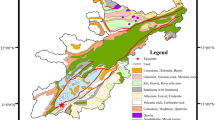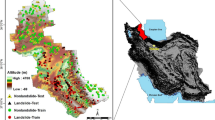Abstract
Landslide is the most dangerous type of natural hazard, with devastating consequences for human life and the economy as a whole. Landslides have become an essential responsibility to decrease their harmful consequences, which involves analyzing landslide-related information and anticipating prospective landslides. In this proposed work, the landslide susceptibility zones and the triggering factors were analyzed and classified using a deep neural network (DNNs). A geographical database is created in this study based on 2018 landslide potential points in Kerala, India. 13 districts and 10 parameters are used to create the geographic database: polygon length, polygon width, polygon area, buildings, roads, agricultural data, land use, land cover, longitude, and latitude. A DNN model is generated using fine-tuned parameter with 4728 historic landslide points. This proposed work predominantly concentrates on the experimental aspect, particularly the DNN architecture model has employed for training the dataset. This design employs the adamax optimizer, tanh as an activation function, and four hidden layers with a learning rate of 0.01 to get the highest accuracy with the minimum loss. We found 98.16% as the maximum accuracy after numerous testing operations, implying that the landslide in Kerala was primarily caused by debris flow.
Access this chapter
Tax calculation will be finalised at checkout
Purchases are for personal use only
Similar content being viewed by others
References
Andrewwinner, R., Chandrasekaran, S.S.: Investigation on the Failure Mechanism of Rainfall-Induced Long-Runout Landslide at Upputhode, Kerala State of India. (2021). https://doi.org/10.3390/land10111212
Kuriakose, S.L., Sankar, G., Muraleedharan, C.: History of landslide susceptibility and a chorology of landslide-prone areas in the Western Ghats of Kerala, India. Environ. Geol. 57(7), 1553–1568 (2008). https://doi.org/10.1007/s00254-008-1431-9
Achu, A.L., Aju, C.D., Reghunath, R.: Spatial modelling of shallow landslide susceptibility: a study from the southern Western Ghats region of Kerala, India. Ann. GIS 26(2), 113–131 (2020). https://doi.org/10.1080/19475683.2020.1758207
Jones, S., Kasthurba, A.K., Bhagyanathan, A., Binoy, B.V.: Landslide susceptibility investigation for Idukki district of Kerala using regression analysis and machine learning. Arab. J. Geosci. 14(10), 1–17 (2021). https://doi.org/10.1007/s12517-021-07156-6
Parthasarathy, K.S.S., Deka, P.C., Saravanan, S., Abijith, D., Jacinth Jennifer, J.: Assessing the impact of 2018 tropical rainfall and the consecutive flood-related damages for the state of Kerala, India. Disaster Resil. Sustain., 379–395 (2021). https://doi.org/10.1016/B978-0-323-85195-4.00013-5
Bhargavi, G.: J.A.-J. of C. Reviews, and undefined, Land risk susceptibility, hazard and risk factors in western ghats, india–a review. jcreview.com (2020)
Mantovani, F., Soeters, R., Van Westen, C.J.: Remote sensing techniques for landslide studies and hazard zonation in Europe. Geomorphology 15(3–4), 213–225 (1996). https://doi.org/10.1016/0169-555X(95)00071-C
Abraham, M.T., Pothuraju, D., Satyam, N.: Rainfall Thresholds for Prediction of Landslides in Idukki, India: An Empirical Approach. (2019). https://doi.org/10.3390/w11102113
Abraham, M.T., Pothuraju, D., Satyam, N.: Rainfall thresholds for prediction of landslides in Idukki, India: an empirical approach. Water 11(10), 2113 (2019). https://doi.org/10.3390/w11102113
Chávez-García, F.J., Natarajan, T., Cárdenas-Soto, M., Rajendran, K.: Landslide characterization using active and passive seismic imaging techniques: a case study from Kerala, India. Nat. Hazards 105(2), 1623–1642 (2020). https://doi.org/10.1007/s11069-020-04369-y
Manoharan, K.G., Nehru, J.A., Balasubramanian, S.: Artificial Intelligence and IoT.
Khosravi, K., et al.: A comparative assessment of decision trees algorithms for flash flood susceptibility modeling at Haraz Watershed, Northern Iran. Sci. Total Environ. 627, 744–755 (2018). https://doi.org/10.1016/j.scitotenv.2018.01.266
Ragedhaksha, Darshini, Shahil, Arunnehru, J.: Deep learning-based real-world object detection and improved anomaly detection for surveillance videos. Mater. Today Proc. (2021). https://doi.org/10.1016/J.MATPR.2021.07.064
Acharjya, D.P., Geetha, M.K. (eds.): Internet of things: novel advances and envisioned applications. SBD, vol. 25. Springer, Cham (2017). https://doi.org/10.1007/978-3-319-53472-5
Feng, J., Lu, S.: Performance analysis of various activation functions in artificial neural networks. J. Phys. Conf. Ser. 1237(2), 022030 (2019). https://doi.org/10.1088/1742-6596/1237/2/022030
Buscombe, D., Ritchie, A.C.: Landscape Classification with Deep Neural Networks. https://doi.org/10.3390/geosciences8070244
Zintgraf, L.M., Cohen, T.S., Adel, T., Welling, M.: Visualizing Deep Neural Network Decisions: Prediction Difference Analysis. (2017)
Hu, X., Zhang, H., Mei, H., ** Using the Stacking Ensemble Machine Learning Method in Lushui, Southwest China. (2020). https://doi.org/10.3390/app10114016
Drusch, M., et al.: Sentinel-2: ESA’s optical high-resolution mission for GMES operational services. Remote Sens. Environ. (2012). https://doi.org/10.1016/j.rse.2011.11.026
Luo, X., et al.: Mine landslide susceptibility assessment using IVM, ANN and SVM models considering the contribution of affecting factors. (2019). https://doi.org/10.1371/journal.pone.0215134
Yao, J., Qin, S., Qiao, S., Che, W., Chen, Y., Miao, Q.: Assessment of Landslide Susceptibility Combining Deep Learning with Semi-Supervised Learning in Jiaohe County, Jilin Province, China. https://doi.org/10.3390/app10165640
Quang, V.N.B., Viet, L.D., Chi, C.N., Duc, P.V.N., Quang, B.N.: Predicting Landslide Spatial Probability in Quang Ngai, Vietnam using Deep Learning Technique. In: 4th Asia Pacific Meeting on Near Surface Geoscience & Engineering, vol. 2021, no. 1, pp. 1–5, (2021). https://doi.org/10.3997/2214-4609.202177052
Man, A., Pradhan, S., Kim, Y.-T.: Geo-Information Rainfall-Induced Shallow Landslide Susceptibility Map** at Two Adjacent Catchments Using Advanced Machine Learning Algorithms. https://doi.org/10.3390/ijgi9100569
Bradley, A.P.: The use of the area under the ROC curve in the evaluation of machine learning algorithms. Pattern Recognit. 30(7), 1145–1159 (1997). https://doi.org/10.1016/S0031-3203(96)00142-2
Author information
Authors and Affiliations
Corresponding author
Editor information
Editors and Affiliations
Rights and permissions
Copyright information
© 2022 The Author(s), under exclusive license to Springer Nature Switzerland AG
About this paper
Cite this paper
Bhargavi, G., Arunnehru, J. (2022). Identification of Landslide Vulnerability Zones and Triggering Factors Using Deep Neural Networks – An Experimental Analysis. In: Singh, M., Tyagi, V., Gupta, P.K., Flusser, J., Ören, T. (eds) Advances in Computing and Data Sciences. ICACDS 2022. Communications in Computer and Information Science, vol 1613. Springer, Cham. https://doi.org/10.1007/978-3-031-12638-3_11
Download citation
DOI: https://doi.org/10.1007/978-3-031-12638-3_11
Published:
Publisher Name: Springer, Cham
Print ISBN: 978-3-031-12637-6
Online ISBN: 978-3-031-12638-3
eBook Packages: Computer ScienceComputer Science (R0)




